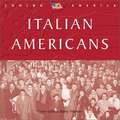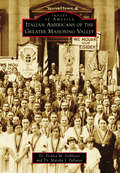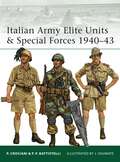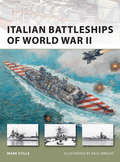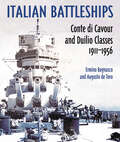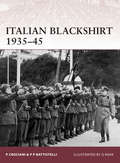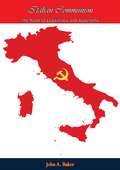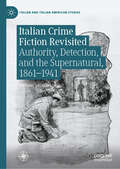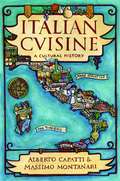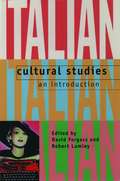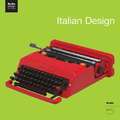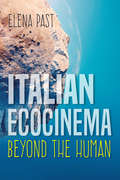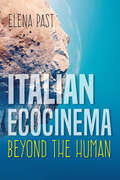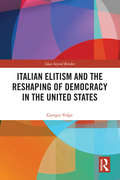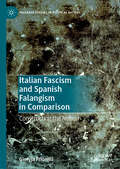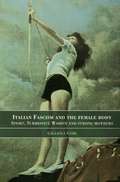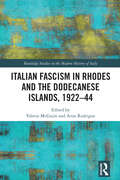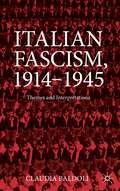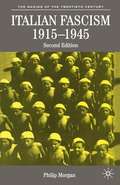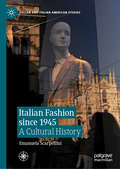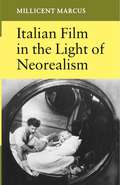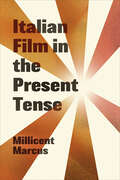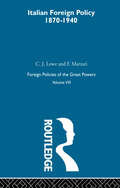- Table View
- List View
Italian Americans (Coming To America)
by Barry MorenoHere are vivid evocations of New York’s Little Italy and San Francisco’s Italian community around Fisherman’s Wharf, along with the warm family life and neighborhood festivals, the wonderful Italian cuisine, the merchants and tradesmen, the underworld figures, the political leaders, and much more. Brief biographies touch on the lives of physicist Enrico Fermi, politicians Fiorello LaGuardia and Rudolph Giuliani, sportsman Joe DiMaggio, and many others.
Italian Americans of the Greater Mahoning Valley (Images of America)
by Dr Martha Pallante Dr Donna DeblasioBetween 1890 and 1924, Italian immigrants flocked to Ohio's Mahoning Valley. The area's burgeoning iron and steel industries beckoned with job prospects for immigrants fleeing southern and eastern Europe--particularly from southern Italy, a region that at the time lacked opportunity and highly taxed its natives. Upon the arrival of these new residents, neighborhoods such as Youngstown's Smoky Hollow and Brier Hill offered accepting communities, and Niles Fire Brick Factory Company and Trumbull Blast Furnace provided employment. Assimilation was not always easy, and discrimination did occur, but Italian Americans ultimately prospered, making a mark not only as steelworkers but also as shopkeepers, grocers, restaurateurs, tradesmen, educators, doctors, lawyers, legislators, and mayors. This book explores the immigration experience, community, workplace dynamics, celebrations, worship, heritage, and lasting impact of the second-largest ethnic group in Ohio's Mahoning Valley.
Italian Army Elite Units & Special Forces 1940-43
by Pier Battistelli Johnny ShumateItalian military historian Pier Paolo Battistelli examines the elite and specialforces units of the Italian Army during World War II. This includes a vast array of troop types, including paratroopers, assault engineers, sea-landing and swimmer units, long-range recce and ski units, and even hand-picked Fascist 'Mussolini' units. It also delves into the specialist tank and armoured units that were created to emulate the German armoured units. While the Italian units discussed enjoyed mixed success, the volume draws attention to the incredibly hard fighting done by some in the deserts of North Africa and the frozen wastelands of Russia. Illustrated with rare archival photographs and specially commissioned artwork, this is a fascinating insight into a little-studied aspect of Axis forces.
Italian Battleships of World War II
by Paul Wright Mark StilleOften overlooked as a naval power of WWII, Italy's Regia Marina was, upon the declaration of war against France, the fourth largest navy in the world. Despite its numbers, the Italian fleet was made up of largely obsolete vessels, none being equipped with radar, and had a reputation for having inadequately-trained crews. Added to these drawbacks, the Italian commanders did not enjoy the discretion of command at sea that their counterparts in the service of other nations did, being directed closely by the Supermarina (Italian Naval Headquarters). Despite these obstacles, and the heavy losses inflicted upon the fleet by the Royal Navy while in harbour at Taranto, the battleships of the Italian Navy enjoyed a good reputation for being well-designed, and served with courage and determination at Punto Stilo/Calabria, Sirte, Cape Spartivento, and Cape Matapan. Mark Stille details, with the aid of many stunning photographs, including several from the Italian Navy's own archives, the battleships of one of the forgotten navies of WWII.From the Trade Paperback edition.
Italian Battleships: Conte di Cavour and Duilio Classes 1911–1956
by Erminio Bagnasco Augusto de ToroWith the publication of their previous book on the battleships of the Littorio class, the authors set new standards for the detailed coverage and sophisticated analysis of Italian warship design. Inspired by its success, both critically and commercially, the authors were inspired to follow up with a similar study of the earlier Italian battleships that were built in the First World War but survived to fight in the Second. Given the level of new research required, this has taken a decade to achieve but the result is a similarly comprehensive coverage. Originally comprising five ships in two related classes, they entered service at the beginning of the Great War. As designed, they were powerful examples of the second generation of dreadnoughts, with a combination of twin and triple turrets producing a unique main armament of thirteen 12-inch guns. One ship, Leonardo da Vinci, was sunk by an internal explosion at Taranto in 1916, and although the hull was raised post-war, the plan to rebuild the ship was abandoned as it was not deemed cost-effective. However, the remaining four ships were to undergo one of the most radical reconstructions of any battleship class during the 1930s, emerging with an entirely new profile, more powerful machinery and all the characteristics of a modern fast battleship. In this form they became an important element in the Italian fleet that opposed the British after 1940\. This book covers all the technical details of the ships, both as built and as rebuilt, but also provides an extended history of their active service, including battle plans and track charts. Thoroughly illustrated with photographs, ship and armament plans, detail drawings and colour camouflage schemes, the book is a fitting companion to The Littorio Class.
Italian Blackshirt 1935-45
by Pier Battistelli Giuseppe RavaThe Blackshirt legions were raised under army control from 1928, and were employed in 1933 in Libya in counterinsurgency operations against the Senussi tribes; from 1935 in Italy's war against Ethiopia; and during the Spanish Civil War. Following the outbreak of World War II, the Blackshirts fought in North Africa, Greece, Croatia, on the Eastern Front and finally in Italy itself following the Allied invasion.This book documents the experiences of the Italian armed Fascist militia, the Camicie Nere (Blackshirts), from the Italian-Ethiopian war (1935-1936), through the Spanish Civil War (1936-1939) to the end of World War II (1939-1945). It explores their origins, development, recruitment, training, conditions of service, uniforms and equipment, battle experience, political and ideological motivation.
Italian Communism: The Road to Legitimacy and Autonomy
by John A. BakerThroughout the Cold War era, many Americans were puzzled that communism could thrive in Italy, a NATO ally with close cultural and social ties to the United States. In this study of Italian Communism and the Italian Communist Party, from its part in the Resistance during World War II to its role in Italy in the eighties, John Baker explains how Italian Communism differs from communism in other nations and why it has flourished in Italy.Dr. Baker concentrates on the Italian Communist Party’s dilemma regarding its relationship with the Soviet Union. Since World War II, Italian Communists have sought to participate in governing Italy. As long as the Party was associated with the aspirations of the Soviet Union, however, it was suspect in the eyes of the Italian electorate and Italy’s allies. Thus, to gain influence in Italian politics, the Party was forced to “deradicalize,” that is, to disclaim endorsement of non-democratic methods and to distance itself from Soviet foreign policy. Dr. Baker traces this gradual and successful process of deradicalization.
Italian Crime Fiction Revisited: Authority, Detection, and the Supernatural, 1861–1941 (Italian and Italian American Studies)
by Stefano SerafiniThis book offers the first extensive investigation of Italian crime fiction in the period between 1861, the year of Italy’s unification, and 1941, when the famous Mondadori series ‘I libri gialli’, which had published crime novels since 1929, was suppressed by the fascist regime. By exploring the formal and thematic metamorphoses of Italian crime narratives and probing the different socio-political roles that they played in both the liberal and fascist periods, it provides a radical re-conceptualization, in both historical and theoretical terms, of a form of fiction that has been largely marginalized for both aesthetic and ideological reasons, uncovering how it was implicated in the construction of the modern state and in the articulation and shaping of the process of ‘making Italians’.
Italian Cuisine: A Cultural History (Arts and Traditions of the Table: Perspectives on Culinary History)
by Massimo Montanari Alberto CapattiItaly, the country with a hundred cities and a thousand bell towers, is also the country with a hundred cuisines and a thousand recipes. Its great variety of culinary practices reflects a history long dominated by regionalism and political division, and has led to the common conception of Italian food as a mosaic of regional customs rather than a single tradition. Nonetheless, this magnificent new book demonstrates the development of a distinctive, unified culinary tradition throughout the Italian peninsula.Alberto Capatti and Massimo Montanari uncover a network of culinary customs, food lore, and cooking practices, dating back as far as the Middle Ages, that are identifiably Italian:o Italians used forks 300 years before other Europeans, possibly because they were needed to handle pasta, which is slippery and dangerously hot.o Italians invented the practice of chilling drinks and may have invented ice cream.o Italian culinary practice influenced the rest of Europe to place more emphasis on vegetables and less on meat.o Salad was a distinctive aspect of the Italian meal as early as the sixteenth century.The authors focus on culinary developments in the late medieval, Renaissance, and Baroque eras, aided by a wealth of cookbooks produced throughout the early modern period. They show how Italy's culinary identities emerged over the course of the centuries through an exchange of information and techniques among geographical regions and social classes. Though temporally, spatially, and socially diverse, these cuisines refer to a common experience that can be described as Italian. Thematically organized around key issues in culinary history and beautifully illustrated, Italian Cuisine is a rich history of the ingredients, dishes, techniques, and social customs behind the Italian food we know and love today.
Italian Cultural Studies: An Introduction
by David Forgacs Robert LumleyThis illustrated introduction to the study of modern Italian culture brings together specialists in the fields of language; politics; religious, ethnic, and gender identities; the mass media; cultural policy; and movie stars. In four thematic sections, the contributors elucidate their own slice of Italian culture. Geographies questions received notions of the Italian nation, the family, the "South" and corruption; it also looks at anthropological approaches to culture and at Italy's linguistic pluralism. Identities examines gender, religion, politics, and ethnicity as a means by which people define themselves and others. Media explores the press, literature, television, and cinema. Culture and Society brings together historical analyses of cultural policy, stars and style, and popular music. The book includes guidance for further reading and a chronology of political and cultural events since 1900.
Italian Design (MoMA Design Series)
by Giampiero BosoniThis volume explores Italian design of the last half-century, featuring the classic lines of the Vespa, Bruno Munari's deconstruction of the common fork, the nostalgic appeal of Italo Marchioni's ice cream cone and the sleek Minimalism of Alberto Meda's 1987 "Light Light Chair," among many other masterpieces.
Italian Ecocinema Beyond the Human (New Directions in National Cinemas)
by Elena PastEntangled in the hybrid fields of ecomedia studies and material ecocriticism, Elena Past examines five Italian films shot on location and ponders the complex relationships that the production crews developed with the filming locations and the nonhuman cast members. She uses these films—Red Desert (1964), The Winds Blows Round (2005), Gomorrah (2008), Le quattro volte (2010), and Return to the Aeolian Islands (2010)—as case studies to explore pressing enviornmental questions such as cinema's dependence on hydrocarbons, the toxic waste crisis in the region of Campania, and our reliance on the nonhuman world. Dynamic and unexpected actors emerge as the subjects of each chapter: playful goats, erupting volcanoes, airborne dust particles, fluid petroleum, and even the sound of silence. Based on interviews with crew members and close readings of the films themselves, Italian Ecocinema Beyond the Human theorizes how filmmaking practice—from sound recording to location scouting to managing a production—helps uncover cinema's ecological footprint and its potential to open new perspectives on the nonhuman world.
Italian Ecocinema: Beyond the Human (New Directions in National Cinemas)
by Elena PastEcocriticism and film studies unite in this examination of five Italian films and the environmental questions they raise.Entangled in the hybrid fields of ecomedia studies and material ecocriticism, Elena Past examines five Italian films shot on location and ponders the complex relationships that the production crews developed with the filming locations and the nonhuman cast members. She uses these films—Red Desert (1964), The Winds Blows Round (2005), Gomorrah (2008), Le quattro volte (2010), and Return to the Aeolian Islands (2010)—as case studies to explore pressing environmental questions such as cinema’s dependence on hydrocarbons, the toxic waste crisis in the region of Campania, and our reliance on the nonhuman world. Dynamic and unexpected actors emerge as the subjects of each chapter: playful goats, erupting volcanoes, airborne dust particles, fluid petroleum, and even the sound of silence. Based on interviews with crew members and close readings of the films themselves, Italian Ecocinema Beyond the Human theorizes how filmmaking practice—from sound recording to location scouting to managing a production—helps uncover cinema’s ecological footprint and its potential to open new perspectives on the nonhuman world.“[Past] uniquely and innovatively combines film studies and material ecocriticism with a focus on Italy. Such weaving of tales brings the films to life and reads them as ecological documents and Italian stories.” —Heather I. Sullivan, author of The Intercontextuality of Self and Nature in Ludwig Tieck’s Early Works“A timely and incisive study that interrogates a new, though growing, trend in film criticism and makes an important and rich contribution to Italian film studies, Italian cultural studies, and ecocriticism.” —Bernadette Luciano, author (with Susanna Scarparo) of Reframing Italy: New Trends in Italian Women’s Filmmaking“Part memoir, part close analysis of the films themselves, and illustrated with numerous excellent frame grabs, Past’s book casts a dreamlike spell as it contemplates the past, present, and future of the cinema and moves smoothly between environmental issues and aesthetic and practical concerns.” —Choice
Italian Ecocinema: Beyond the Human (New Directions in National Cinemas)
by Elena PastEcocriticism and film studies unite in this examination of five Italian films and the environmental questions they raise.Entangled in the hybrid fields of ecomedia studies and material ecocriticism, Elena Past examines five Italian films shot on location and ponders the complex relationships that the production crews developed with the filming locations and the nonhuman cast members. She uses these films—Red Desert (1964), The Winds Blows Round (2005), Gomorrah (2008), Le quattro volte (2010), and Return to the Aeolian Islands (2010)—as case studies to explore pressing environmental questions such as cinema’s dependence on hydrocarbons, the toxic waste crisis in the region of Campania, and our reliance on the nonhuman world. Dynamic and unexpected actors emerge as the subjects of each chapter: playful goats, erupting volcanoes, airborne dust particles, fluid petroleum, and even the sound of silence. Based on interviews with crew members and close readings of the films themselves, Italian Ecocinema Beyond the Human theorizes how filmmaking practice—from sound recording to location scouting to managing a production—helps uncover cinema’s ecological footprint and its potential to open new perspectives on the nonhuman world.“[Past] uniquely and innovatively combines film studies and material ecocriticism with a focus on Italy. Such weaving of tales brings the films to life and reads them as ecological documents and Italian stories.” —Heather I. Sullivan, author of The Intercontextuality of Self and Nature in Ludwig Tieck’s Early Works“A timely and incisive study that interrogates a new, though growing, trend in film criticism and makes an important and rich contribution to Italian film studies, Italian cultural studies, and ecocriticism.” —Bernadette Luciano, author (with Susanna Scarparo) of Reframing Italy: New Trends in Italian Women’s Filmmaking“Part memoir, part close analysis of the films themselves, and illustrated with numerous excellent frame grabs, Past’s book casts a dreamlike spell as it contemplates the past, present, and future of the cinema and moves smoothly between environmental issues and aesthetic and practical concerns.” —Choice
Italian Elitism and the Reshaping of Democracy in the United States (Ideas beyond Borders)
by Giorgio VolpeThis book deals with the reception of Italian elitism in the United States, identifying its key protagonists, phases, and themes. It starts from the reconstruction of the scientific and political debates aroused in the United States by the works of Mosca, Pareto, and Michels, and moves on to define their theoretical influence in the American scientific and academic contexts. The analysis takes into consideration the period from the first contact between elitists and American academia in the early 1920s to the publication of The Power Elite by Mills, in 1956, which marks the emancipation of American elitism. After introducing the fundamental principles of elite theory, the first part of the study reconstructs the debate that it aroused beyond the Atlantic. The second part examines the original American reworking of the elitist lesson, concentrating on the works of the authors most strongly influenced by it: Joseph A. Schumpeter, Harold D. Lasswell, and Charles W. Mills. The book aims to shed light on the contribution of Italian elitism to the development of American political thought.
Italian Fascism and Spanish Falangism in Comparison: Constructing the Nation (Palgrave Studies in Political History)
by Giorgia PriorelliThis book compares the Italian Fascist and the Spanish Falangist political cultures from the early 1930s to the early 1940s, using the idea of the nation as the focus of the comparison. It argues that the discourse on the nation represented a common denominator between these two manifestations of the fascist phenomenon in Mussolini’s Italy and Franco’s Spain. Exploring the similarities and differences between these two political cultures, this study investigates how Fascist and Falangist ideologues defined and developed their own idea of the nation over time to legitimise their power within their respective countries. It examines to what extent their concept of the nation influenced Italian and Spanish domestic and foreign policies. The book offers a four-level framework for understanding the evolution of the fascist idea of the nation: the ideology of the nation, the imperial projects of Fascism and Falangism, race and the nation, and the place of these cultures in the new Nazi continental order. In doing so, it shows how these ideas of the nation had significant repercussions on fascist political practice.
Italian Fascism and the Female Body: Sport, Submissive Women and Strong Mothers (Sport in the Global Society)
by Gigliola GoriThis is the first text to examine women and sport in Italy during the period 1861-1945. To qualify and quantify the impact of fascism on Italian Women's sport, the author first of all examines the pre-fascist period in terms of female physical culture. The text then describes how during the fascist era, women moved strictly within a framework designed by medicine and eugenics, religious and traditional education. The country aspired to emancipation, as promised by the fascist revolution but emancipation was hard to advance under the fascist regime because of male hegemonic trends in the country. This book shows how the engagement of women in some sporting activity did promote and support some gender emancipation. The conclusion of the book demonstrates how, in the post-war period, women found it hard to advance further on, for a number of reasons.
Italian Fascism in Rhodes and the Dodecanese Islands, 1922–44 (Routledge Studies in the Modern History of Italy)
by Aron Rodrigue Valerie McGuireThis book is the first English-language collection of scholarly essays to investigate the ambiguous and supporting role that colonialism in the Aegean Region played in Mussolini’s imperial ambitions, bringing to light a history rarely scrutinized until recently.The Dodecanese archipelago is often absent from histories of Italian fascist colonialism, as Italian territories in East Africa, Libya, and the Balkans have figured more centrally in discussions of how nationalism and later fascism relied on the empire to promote discourses of national renewal and regeneration. Over the past twenty years, a new wave of research has emerged, animated by the opening of previously closed state archives in various countries. This volume’s international contributors provide fresh perspectives on a topic frequently mythologized as a “golden period” of social and cultural intimacy among twentieth-century Greeks, Turks, and Jews. Themes include the fascist adaptation in the islands of Ottoman imperial governance, programs of infrastructure, development, and administration in the Dodecanese, Jewish history and memory in Rhodes, and the place of the islands in larger regional tensions of the interwar period. The volume will be of interest to scholars of Italian history, modern colonialism, fascism, Mediterranean studies, the end of the Ottoman Empire, and Sephardic Jewry.
Italian Fascism, 1914-1945: Themes and Interpretations
by Claudia BaldoliThis is the first book on Italian Fascism to analyse the rich historiography written in Italian for the benefit of the English-speaking students. Claudia Baldoli clarifies the most important research and debates from the origins of Fascism to the ways in which it is remembered today.
Italian Fascism, 1915–1945: Second Edition (The\making Of The Twentieth Century Ser.)
by Philip MorganIt is now 80 years since Mussolini's Fascism came to power in Italy, but the political heirs of the original Fascism are part of government in today's Italy. The resurgence of neo-fascist and neo-Nazi extremism all over Europe are a reminder of the continuing place of fascism in contemporary European society, despite its political and military defeat in 1945. This thoroughly revised, updated and expanded edition provides a critical and comprehensive overview of the origins of Fascism and the movement's taking and consolidation of power. Philip Morgan: #65533; explains how the experience of the First World War created Fascism #65533; describes how the unsettled post-war conditions in Italy enabled an initially small group of political adventurers around Mussolini to build a large movement and take power in 1922 #65533; focuses on the workings of the first ever 'totalitarian' system and its impacts on the lives and outlooks of ordinary Italians #65533; considers the meshing of internal 'fascistisation' and expansionism, which emerged most clearly after 1936 as Italy became more closely aligned with Nazi Germany #65533; examines the demise of Italian Fascism between 1943 and 1945 as Mussolini and his party became the puppets of Nazism #65533; provides an explanation and interpretation of Fascism, locating it in contemporary history and taking account of recent debates on the nature of the phenomenon. Clear and approachable, this essential text is ideal for anyone interested in Italy's turbulent political history in the first half of the twentieth century.
Italian Fashion since 1945: A Cultural History (Italian and Italian American Studies)
by Emanuela ScarpelliniIn the course of the twentieth century, Italy succeeded in establishing itself as one of the world's preeminent fashion capitals, despite the centuries-old predominance of Paris and London. This book traces the story of how this came to be, guiding readers through the major cultural and economic revolutions of twentieth-century Italy and how they shaped the consumption practices and material lives of everyday Italians. In order to understand the specific character of the “Italian model,” Emanuela Scarpellini considers not only aspects of craftsmanship, industrial production and the evolution of styles, but also the economic and cultural changes that have radically transformed Italy and the international scene within a few decades: the post-war economic miracle, the youth revolution, the consumerism of the 1980s, globalization, the environmentalism of the 2000s and the Italy of today. Written in a lively style, full of references to cinema, literature, art and the world of media, this work offers the first comprehensive overview of a phenomenon that has profoundly shaped recent Italian history.
Italian Film in the Light of Neorealism
by Millicent MarcusThe movement known as neorealism lasted seven years, generated only twenty-one films, failed at the box office, and fell short of its didactic and aesthetic aspirations. Yet it exerted such a profound influence on Italian cinema that all the best postwar directors had to come to terms with it, whether in seeming imitation (the early Olmi), in commercial exploitation (the middle Comencini) or in ostensible rejection (the recent Tavianis). Despite the reactionary pressures of the marketplace and the highly personalized visions of Fellini, Antonioni. And Visconti, Italian cinema has maintained its moral commitment to use the medium in socially responsible ways--if not to change the world, as the first neorealists hoped, then at least to move filmgoers to face the pressing economic, political, and human problems in their midst. From Rossellini's Open City (1945) to the Taviani brothers' Night of the Shooting Stars (1982). The author does close readings of seventeen films that tell the story of neorealism's evolving influence on Italian postwar cinematic expression.Other films discussed are De Sica's Bicycle Thief and Umberto D. De Santis's Bitter Rice, Comencini's Bread, Love, and Fantasy, Fellini's La strada, Visconti's Senso, Antonioni's Red Desert, Olmi's Il Posto, Germi's Seduced and Abandoned, Pasolini's Teorema, Petri's Investigation of a Citizen above Suspicion, Bertolucci's The Conformist, Rosi's Christ Stopped at Eboli, and Wertmuller's Love and Anarchy, Scola's We All Loved Each Other So Much provides the occasion for the author's own retrospective consideration of how Italian cinema has fulfilled, or disappointed, the promise of neorealism.
Italian Film in the Present Tense (Toronto Italian Studies)
by Millicent MarcusFor observers of the European film scene, Federico Fellini’s death in 1993 came to stand for the demise of Italian cinema as a whole. Exploring an eclectic sampling of works from the new millennium, Italian Film in the Present Tense confronts this narrative of decline with strong evidence to the contrary. Millicent Marcus highlights Italian cinema’s new sources of industrial strength, its re-placement of the Rome-centred studio system with regional film commissions, its contemporary breakthroughs on the aesthetic front, and its vital engagement with the changing economic and socio-political circumstances in twenty-first-century Italian life. Examining works that stand out for their formal brilliance and their moral urgency, the book presents a series of fourteen case studies, featuring analyses of such renowned films as Il Divo, Gomorrah, The Great Beauty, We Have a Pope, The Mafia Only Kills in the Summer, and Fire at Sea, along with lesser-known works deserving of serious critical scrutiny. In doing so, Italian Film in the Present Tense contests the widely held perception of a medium languishing in its "post-Fellini" moment, and instead acknowledges the ethical persistence and forward-looking currents of Italian cinema in the present tense.
Italian Foreign Policy 1870-1940: Volume VIII
by C.J. Lowe F. MarzariThis is Volume VIII of eleven in a collection of works on Foreign Policies of the Great Powers. Originally published in 1975, and looks at the polices of Italy from 1870 to 1940 including topics from independence to alliance, Mancini, Robilant, the Crispi period, the Prinetti-Barrere agreement, War during 1914 and 15, Mussolini, Italo-French relations, The Rome-berlin Axis, and the war in 1940.
Italian Forgers: The Art Market and the Weight of the Past in Modern Italy
by Carol HelstoskyItalian Forgers takes an unorthodox approach to the fascinating topic of art forgery, focusing not on art forgery per se, but on the major forgery scandals that shifted the Italian art market in response to constant, and often intense, demand for Italian objects. By focusing on power dynamics that both precipitated forgery scandals and forged Italian cultural identities, this book connects the debates and discussions about three well-known Italian forgers—Giovanni Bastianini, Icilio Joni, and Alceo Dossena—to anchor and investigate the mechanics of the Italian art market from unification through the fascist era.Carol Helstosky examines foreign accounts of transactions and Italian writings about the art market. The actions and words of Italian dealers illustrate how the Italian art and antiquities market was an undeniably modern industry, on par with tourism in terms of its contribution to the Italian economy and to understandings of Italian identity. These accounts also reveal how dealers, artists, go-betweens, guides, and restorers worked to not only meet the intense demand for Italian products but also to develop highly sophisticated business practices to maintain financial stability and respond to shifts in demand consciously (but not always conscientiously).Italian Forgers weaves a compelling narrative about the history of Italian identity, forgery, and the value of the past. As a result, Helstosky brings historical perspective to the study of art forgery and art fraud. She reveals how historical circumstances and structural imbalances of cultural power shaped the market for art and antiquities and amplified incidents of art deception and forgery scandals.
